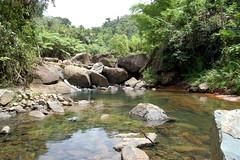 |
| Rain forest NZ (Photo credit: Wikipedia) |
One major issue that harms the environment as well as mankind is lead. Many people have long forgotten about the dangers of lead and think this is an issue that has already been handled. However, there are many lead sources still around us in many forms. Lead can be found in homes built before 1978, soil, paint, dust particles, drinking water, old smelters, and some work places. This is a problem for all of us because the sources are so numerous and a part of our everyday lives.
 |
| Rain forest (Photo credit: laura0509) |
The cost of the problem is decreasing over time. As we continue to eliminate lead from our production we are seeing fewer issues associated with lead. However, there are still many sources of lead in existence. Many of our homes have lead supplies built into the structure. Many of us have lead paint at the core of the walls. It will take a significant amount of time to contain and hopefully eliminate lead in our daily lives. The current cost issues right now can be linked to health care that has been needed as direct responses to lead related illnesses.
Looking at solutions, it may not be feasible to actually eliminate lead from our environment, but containment has been the popular solution in recent decades. Many homes that contain lead paint encourage owners to either have the paint removed or isolated within the walls. In regards to the soil, communities encourage children not to play in the soil and to wash thoroughly in order to prevent any lead dust or particles from getting into food, water, or airways of people. The best solution for lead is two-fold. The continued non-use of lead substances will help diminish lead-related illnesses coupled with the isolation of current lead products will continue to address the lead problems in our society.
 |
| Rain forest around Mt Kenya 1 (Photo credit: Wikipedia) |
The Code of Federal Regulations (CFR) has a section regarding the prevention of lead based paint poisoning. The Toxic Substances Control Act (TSCA) also regulates the use of lead products in homes and workplaces. The Environmental Protection Agency (EPA) and lawmakers utilize CFRs, TSCAs, and other legislation to regulate the use, handling, isolation, and clean-up of lead. Many third world countries, especially China, do not have such restrictions on lead use in everyday products as more industrialized countries do. The use of lead in products is cost efficient and that is why it is often permitted.
Lead poisoning lawyers
Reference:
US Environmental Protection Agency. “Lead in Paint, Dust, and Soil.” Accessed: July 1,
Publishing: San Francisco, 2009.

No comments:
Post a Comment